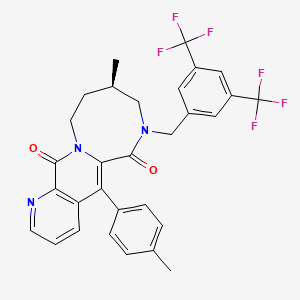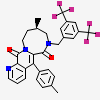Tak-637
PubChem CID
9894349
Molecular Formula
Synonyms
- TAK-637
- TAK 637
- UNII-QRT7W0TL6X
- QRT7W0TL6X
- (9R)-7-[[3,5-bis(trifluoromethyl)phenyl]methyl]-9-methyl-5-(4-methylphenyl)-8,9,10,11-tetrahydro-[1,4]diazocino[2,1-g][1,7]naphthyridine-6,13-dione
Molecular Weight
573.5 g/mol
Computed by PubChem 2.1 (PubChem release 2021.05.07)
Dates
- Create:2006-10-25
- Modify:2025-01-18
Chemical Structure Depiction

(9R)-7-[[3,5-bis(trifluoromethyl)phenyl]methyl]-9-methyl-5-(4-methylphenyl)-8,9,10,11-tetrahydro-[1,4]diazocino[2,1-g][1,7]naphthyridine-6,13-dione
Computed by Lexichem TK 2.7.0 (PubChem release 2021.05.07)
InChI=1S/C30H25F6N3O2/c1-17-5-7-20(8-6-17)24-23-4-3-10-37-25(23)27(40)39-11-9-18(2)15-38(28(41)26(24)39)16-19-12-21(29(31,32)33)14-22(13-19)30(34,35)36/h3-8,10,12-14,18H,9,11,15-16H2,1-2H3/t18-/m1/s1
Computed by InChI 1.0.6 (PubChem release 2021.05.07)
LDXQLWNPGRANTO-GOSISDBHSA-N
Computed by InChI 1.0.6 (PubChem release 2021.05.07)
C[C@@H]1CCN2C(=C(C3=C(C2=O)N=CC=C3)C4=CC=C(C=C4)C)C(=O)N(C1)CC5=CC(=CC(=C5)C(F)(F)F)C(F)(F)F
Computed by OEChem 2.3.0 (PubChem release 2024.12.12)
C30H25F6N3O2
Computed by PubChem 2.1 (PubChem release 2021.05.07)
183549-93-1
- (aR,9R)-7-(3,5-bis(trifluoromethyl)benzyl)-8,9,10,11-tetrahydro-9-methyl-5-(4-methylphenyl)-7H-(1,4)diazocino(2 1-g)(1,7)naphthyridine-6,13-dione
- TAK 637
- TAK-637
- TAK637
- TAK-637
- TAK 637
- UNII-QRT7W0TL6X
- QRT7W0TL6X
- (9R)-7-[[3,5-bis(trifluoromethyl)phenyl]methyl]-9-methyl-5-(4-methylphenyl)-8,9,10,11-tetrahydro-[1,4]diazocino[2,1-g][1,7]naphthyridine-6,13-dione
- CHEMBL339486
- TAK637
- 183549-93-1
- compound (aR,9R)-8b [PMID: 10508446]
- (Ar,9R)-7-(3,5-bis(trifluoromethyl)benzyl)-8,9,10,11-tetrahydro-9-methyl-5-(4-methylphenyl)-7H-(1,4)diazocino(2,1-g)(1,7)naphthyridine-6,13-dione
- 7H-(1,4)Diazocino(2,1-g)(1,7)naphthyridine-6,13-dione, 7-((3,5-bis(trifluoromethyl)phenyl)methyl)-8,9,10,11-tetrahydro-9-methyl-5-(4-methylphenyl)-, (9R)-
- 217185-75-6
- compound (aR,9R)-8b (PMID: 10508446)
- (9R)-7-((3,5-bis(trifluoromethyl)phenyl)methyl)-9-methyl-5-(4-methylphenyl)-8,9,10,11-tetrahydro-(1,4)diazocino(2,1-g)(1,7)naphthyridine-6,13-dione
- SCHEMBL122948
- GTPL9329
- LDXQLWNPGRANTO-GOSISDBHSA-N
- BDBM50081420
- (7R,9R)-7-(3,5-Bis-trifluoromethyl-benzyl)-9-methyl-5-p-tolyl-8,9,10,11-tetrahydro-7H-1,7,11a-triaza-cycloocta[b]naphthalene-6,12-dione
- (7S,9R)-7-(3,5-Bis-trifluoromethyl-benzyl)-9-methyl-5-p-tolyl-8,9,10,11-tetrahydro-7H-1,7,11a-triaza-cycloocta[b]naphthalene-6,12-dione
- (aR,9R)-7-(3,5-bis(trifluoromethyl)benzyl)-8,9,10,11-tetrahydro-9-methyl-5-(4-methylphenyl)-7H-(1,4)diazocino(2 1-g)(1,7)naphthyridine-6,13-dione
Property Name
Property Value
Reference
Property Name
Molecular Weight
Property Value
573.5 g/mol
Reference
Computed by PubChem 2.1 (PubChem release 2021.05.07)
Property Name
XLogP3-AA
Property Value
6.2
Reference
Computed by XLogP3 3.0 (PubChem release 2021.05.07)
Property Name
Hydrogen Bond Donor Count
Property Value
0
Reference
Computed by Cactvs 3.4.8.18 (PubChem release 2021.05.07)
Property Name
Hydrogen Bond Acceptor Count
Property Value
9
Reference
Computed by Cactvs 3.4.8.18 (PubChem release 2021.05.07)
Property Name
Rotatable Bond Count
Property Value
3
Reference
Computed by Cactvs 3.4.8.18 (PubChem release 2021.05.07)
Property Name
Exact Mass
Property Value
573.18509602 Da
Reference
Computed by PubChem 2.1 (PubChem release 2021.05.07)
Property Name
Monoisotopic Mass
Property Value
573.18509602 Da
Reference
Computed by PubChem 2.1 (PubChem release 2021.05.07)
Property Name
Topological Polar Surface Area
Property Value
53.5 Ų
Reference
Computed by Cactvs 3.4.8.18 (PubChem release 2021.05.07)
Property Name
Heavy Atom Count
Property Value
41
Reference
Computed by PubChem
Property Name
Formal Charge
Property Value
0
Reference
Computed by PubChem
Property Name
Complexity
Property Value
997
Reference
Computed by Cactvs 3.4.8.18 (PubChem release 2021.05.07)
Property Name
Isotope Atom Count
Property Value
0
Reference
Computed by PubChem
Property Name
Defined Atom Stereocenter Count
Property Value
1
Reference
Computed by PubChem
Property Name
Undefined Atom Stereocenter Count
Property Value
0
Reference
Computed by PubChem
Property Name
Defined Bond Stereocenter Count
Property Value
0
Reference
Computed by PubChem
Property Name
Undefined Bond Stereocenter Count
Property Value
0
Reference
Computed by PubChem
Property Name
Covalently-Bonded Unit Count
Property Value
1
Reference
Computed by PubChem
Property Name
Compound Is Canonicalized
Property Value
Yes
Reference
Computed by PubChem (release 2021.05.07)
Follow these links to do a live 2D search or do a live 3D search for this compound, sorted by annotation score. This section is deprecated (see here for details), but these live search links provide equivalent functionality to the table that was previously shown here.
Same Connectivity Count
Same Stereo Count
Same Isotope Count
Same Parent, Connectivity Count
Same Parent, Stereo Count
Same Parent, Isotope Count
Similar Compounds (2D)
Similar Conformers (3D)
Same Count
PubMed Count
Patents are available for this chemical structure:
https://patentscope.wipo.int/search/en/result.jsf?inchikey=LDXQLWNPGRANTO-GOSISDBHSA-N
- ChEMBLLICENSEAccess to the web interface of ChEMBL is made under the EBI's Terms of Use (http://www.ebi.ac.uk/Information/termsofuse.html). The ChEMBL data is made available on a Creative Commons Attribution-Share Alike 3.0 Unported License (http://creativecommons.org/licenses/by-sa/3.0/).http://www.ebi.ac.uk/Information/termsofuse.htmlChEMBL Protein Target Treehttps://www.ebi.ac.uk/chembl/g/#browse/targets
- ChemIDplusChemIDplus Chemical Information Classificationhttps://pubchem.ncbi.nlm.nih.gov/source/ChemIDplus
- FDA Global Substance Registration System (GSRS)LICENSEUnless otherwise noted, the contents of the FDA website (www.fda.gov), both text and graphics, are not copyrighted. They are in the public domain and may be republished, reprinted and otherwise used freely by anyone without the need to obtain permission from FDA. Credit to the U.S. Food and Drug Administration as the source is appreciated but not required.https://www.fda.gov/about-fda/about-website/website-policies#linking
- IUPHAR/BPS Guide to PHARMACOLOGYLICENSEThe Guide to PHARMACOLOGY database is licensed under the Open Data Commons Open Database License (ODbL) https://opendatacommons.org/licenses/odbl/. Its contents are licensed under a Creative Commons Attribution-ShareAlike 4.0 International License (http://creativecommons.org/licenses/by-sa/4.0/)https://www.guidetopharmacology.org/about.jsp#licenseGuide to Pharmacology Target Classificationhttps://www.guidetopharmacology.org/targets.jsp
- Therapeutic Target Database (TTD)
- Japan Chemical Substance Dictionary (Nikkaji)
- PharosLICENSEData accessed from Pharos and TCRD is publicly available from the primary sources listed above. Please respect their individual licenses regarding proper use and redistribution.https://pharos.nih.gov/about
- Springer Nature
- Wiley
- PubChemPFAS and Fluorinated Compounds in PubChemhttps://gitlab.com/uniluxembourg/lcsb/eci/pubchem-docs/-/raw/main/pfas-tree/PFAS_Tree.pdf?inline=false
- Medical Subject Headings (MeSH)LICENSEWorks produced by the U.S. government are not subject to copyright protection in the United States. Any such works found on National Library of Medicine (NLM) Web sites may be freely used or reproduced without permission in the U.S.https://www.nlm.nih.gov/copyright.html
- MolGenieMolGenie Organic Chemistry Ontologyhttps://github.com/MolGenie/ontology/
- PATENTSCOPE (WIPO)SID 389147898https://pubchem.ncbi.nlm.nih.gov/substance/389147898
CONTENTS

